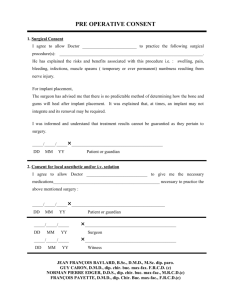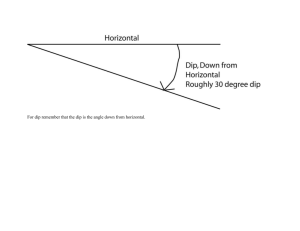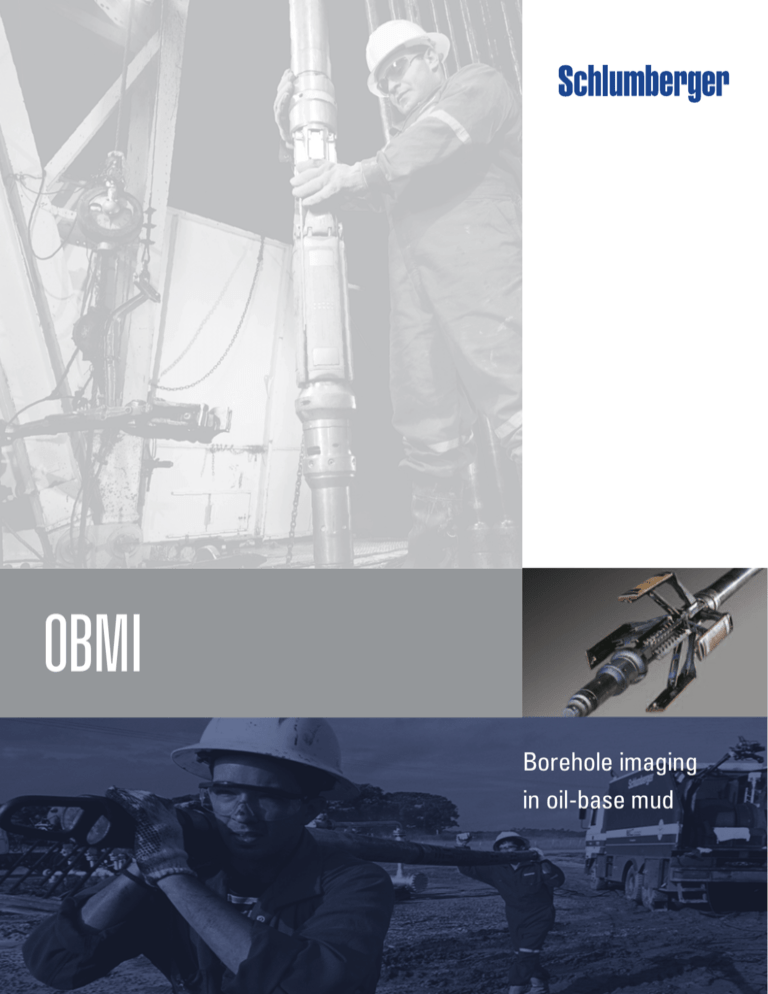
OBMI
Borehole imaging
in oil-base mud
Applications
A tradition of electrical coring
I
Before it was called logging, the downhole measurement of formation properties was called “electrical coring.”
Inspired by this ideal, Schlumberger
developed formation imaging to
advance log structural and stratigraphic
analysis to new levels of insight. The
OBMI* Oil-Base MicroImager tool is
the latest Schlumberger imaging solution and another industry first, extending microresistivity imaging into the
environment of nonconductive invertemulsion mud systems.
I
I
Structural analysis
G
Structural dip determination
G
Fracture and fault detection
Stratigraphic analysis
G
Characterization of
sedimentary deposits
G
Stratigraphic dip
determination
G
Thin-bed detection
Core analysis
G
Depth matching
G
Orientation
G
Missed interval coverage
I
Compartmentalization and
permeability analyses
I
High-resolution net pay count
I
Sample and formation test
positioning
I
Detection of drilling-induced
features
Benefits
I
Detection and measurement
of features too small for
conventional logs
I
Detection of anisotropic
features
I
Differentiation of structural
and stratigraphic features
I
Flexibility retained in
choosing mud systems
The measurement challenge
The increasing use of oil- and syntheticbase mud systems to limit drilling risks
and improve efficiency poses many
challenges for formation imaging.
Even a thin film of nonconductive mud
is essentially an opaque curtain, preventing conventional microresistivity
imagers from measuring the formation.
The presence of nonconductive mudcake or mud filtrate further complicates the situation. Oil-base mud can
be displaced with water-base mud at
considerable expense, but there is no
(a)
Operates in any oil-, dieselor synthetic-base mud
I
High-resolution, oriented
formation image
I
0.4-in. button size, 1.2-in.
resolution
I
Five measurements per pad
I
Quantitative Rxo measurement
I
Compact, integrated design
I
Combinable top and bottom
I
3600 ft/hr maximum logging
speed
I
Two-axis caliper
Uniquely engineered for oil-base mud
The solution for imaging in nonconductive muds pairs cutting-edge technology with a simple, time-honored
principle of resistivity logging. While
logging, the pads of the OBMI tool
are applied against the borehole wall,
where a thin layer of nonconductive
mud is between the pad face and the
formation. In accordance with the
four-terminal or short-normal method
of measuring resistivity, an alternating
current is injected into the formation
between the two electrodes at opposite ends of each pad. The unique
electronics inside the OBMI pad and
cartridge measure the potential difference between paired button electrodes
at the center of the pad. From this
value, the resistivity of the invaded
zone Rxo in the small interval of the
formation opposite the sensors is accurately and quantitatively calculated
using Ohm’s law.
Innovative OBMI technology extends microresistivity image logging to the nonconductive mud environment.
(a) Profile of an OBMI pad applied to the borehole wall, with current I passing between the current electrodes
A and B and measurement of the potential difference between the voltage electrodes C and D. (b) Five pairs
of voltage electrodes on the OBMI pad face.
(b)
Features
I
guarantee that measurement will
be possible. Addressing the need for
images in this difficult environment
clearly demanded a novel approach.
A
I
C
Rxo
D
B
δV
Each of the four pads acquires
five measurements, and the data are
displayed as a color image, oriented
with respect to the geometry of the
tool and borehole. Structural and
stratigraphic features as small as 0.4 in.
[1 cm] can be seen, yielding a wealth of
high-resolution, azimuthal information
unobtainable through conventional
logging techniques. The resemblance
of the OBMI image to whole-round
core enables virtual visualization of the
reservoir—a first for the nonconductive mud environment.
The OBMI tool has been validated
in the field with more than 20 brands
of diesel-, oil- and synthetic-base muds.
In a shale formation that has little
resistivity contrast, automatically computed dips are often in error, and it is
necessary to resort to manual methods.
Using dipmeter data, it is a challenge
to determine the dip in this manner.
The OBMI image (far right track) is developed from five resistivity measurements per pad. OBDT data
(center track) are displayed as a pseudoimage consisting of one data point per pad. OBDT-computed
dips are plotted in red and OBMI dips in black for a sand/shale sequence (top) and low-contrast shale
sequence (bottom).
OBDT
(Sinusoid)
Orientation North
Caliper 1
6
( in.)
6
( in.)
OBMI
True Dip
6
OBMI Resistivity
Gamma Ray
( gAPI )
0.2
120
Engineered for efficiency
( ohm-m )
0
( Deg )
10
MD
1 : 20
( ft )
XXX70
XXX75
Clear dip and structure resolution
XXX50
XXX55
0.2
( ohm-m )
0.2
( ohm-m )
0
20
0
AO10
Borehole Drift
Comparison of OBMI images with an
OBDT* Oil-Base Dipmeter Tool log
acquired in the same well demonstrates
the quantum leap in information for
formation evaluation. In the example
to the right, the value of the highresolution OBMI image is readily
apparent in resolving otherwise ambiguous dip and structural features.
In an interbedded, contrasting
sequence of sand and shale, an automatic algorithm can accurately identify
and compute the formation dip from
both data sets. However, the OBDT
tool measures one curve per pad at a
resolution of about 2 in. The array of
high-resolution sensors on each OBMI
pad provides an image, and bedding
and structure that are unresolved by
the OBDT data are clearly visible.
OBMI
(Sinusoid)
Orientation North
Caliper 2
6
20
Making breakthrough measurements
is but one benefit of the OBMI tool.
The compact, integrated design and
maximum logging speed of 3600 ft/hr
ensure efficient wellsite rig-up and
operation. The through-wired sonde
enables running other services such as
the UBI* Ultrasonic Borehole Imager
below the OBMI tool on the same
descent. To ensure high reliability, the
OBMI tool is built to the same mechanical shock standards as the proven
Platform Express* tools.
The sensitive response of the OBMI
measurement and the image it provides
enable manually picking dips with
confidence. The OBMI data yield accurate dip in this formation even when
processed by the automatic algorithm.
360
Resistive
20
OBDT
90
0
OBDT
True Dip
20
AO90
Deg
Conductive
Conductive
0
( Deg )
90
360
OBMI
Resistive
OBMI images and quantitative Rxo measurement from a deepwater well in the Gulf of Mexico show
an excellent match to the ultraviolet-light core photograph and conventional logs. Thresholds are
applied to the OBMI Rxo data to calculate the net pay thickness in the far-right track.
Deepwater answers in focus
A Gulf of Mexico deepwater operator
ran the OBMI tool in a partially cored
appraisal well to more fully characterize the thinly bedded reservoir sediments and refine the net pay count.
The OBMI image accurately reproduced the cored interval. An abrupt
change in the core dip, previously
thought to be coring induced, was
demonstrated to be natural in origin
by the image.
Stratigraphic analysis was successfully extended beyond the cored interval using the OBMI image. The OBMI
Rxo data correlated well with grain-size
information from sidewall cores. The
resulting net pay count was increased
by more than 50 ft from that determined by conventional log analysis.
Caliper 1
6
Sand
16
( in.)
OBMI Resistivity
Caliper 2
6
16
( in.)
0
20
( gAPI )
120
0.2
( ohm-m )
0.2
( ohm-m )
Shale / Wet Sand
20
Neutron Porosity
AO90
Borehole Drift
0
( Deg )
3
( ohm-m )
AO10
Gamma Ray
10
MD
1:7
( ft )
20
60
0.2
( p.u.)
0
20
( ohm-m )
60
( p.u.)
0
Conductive
Density Porosity
OBMI Resistivity
Cumulative Sand
( ft )
360
OBMI Image
Resistive
Core Image
0
Cumulative Silt
( ft )
Silt
265.04
49.58
XXX82
264.30
49.47
XXX83
264.10
49.34
XXX84
263.70
49.18
XXX85
263.24
48.87
The OBMI image proved that the reversal in dip direction at XXX36.5 ft is a natural feature,
not induced by twisting during the coring process.
OBMI
(Sinusoid)
Orientation North
Caliper 1
6
( in.)
16
Caliper 2
6
( in.)
16
AO10
Gamma Ray
20
( gAPI )
120
0.2
( ohm-m )
20
AO90
0.2
Borehole Drift
0
( Deg )
10
MD
1 : 10
( ft )
XXX35
XXX40
( ohm-m )
20
0
OBMI
True Dip
Conductive
OBMI Resistivity
0.2
( ohm-m )
20 0
( Deg )
90
360
OBMI
Resistive
Core Image
The OBMI image provides a structural overview of the bottom of a pilot hole for a horizontal well in the
Alberta Foothills, confirming the target between XX52 and XX60 m. The accuracy of the OBMI Rxo measurement is verified by excellent correlation with the shallow AIT* Array Induction Imager Tool log.
Insight to structurally complex settings
An operator in the Alberta Foothills,
Canada, drilled a pilot hole for a horizontal well in a poorly bedded reef
buildup. The lateral borehole was
planned to follow the long axis of the
reservoir to maximize the productive
interval. The structural dip—too subtle
for a dipmeter to determine—was
clearly revealed in the OBMI image,
confirming that the reservoir had been
penetrated in the planned location.
The image also confirmed the existence of fractures perpendicular to the
planned lateral, a critical factor for
maximizing productivity.
360
0
Borehole drift
Conductive
0
( Deg )
OBMI Image
Resistive
90
Caliper 1
5
Resistive Fracture
True Dip
15
( in.)
Caliper 2
5
Gamma Ray
0
0
15
( in.)
( gAPI )
150
MD
1 : 200
Bed Boundary
(Sinusoid)
Orientation Top of Hole
AHO10
2
( ohm-m )
(Deg)
Bed Boundary
True Dip
20000
OBMI Resistivity
2
(m)
( ohm-m )
20000 0
(Deg)
XX55
XX60
XX65
XX70
Determining structural dip is challenging in reservoirs such as this massive reef because of the lack of clear
bedding. The OBMI image enables handpicking the dip. A set of fractures (purple) could also be identified.
0
360
Borehole drift
Conductive
0
( Deg )
( in.)
Resistive
90
Caliper 1
5
OBMI Image
15
Bed Boundary
(Sinusoid)
Orientation Top of Hole
Bed Boundary
True Dip
Caliper 2
5
0
Conductive
360
OBMI Image
Resistive
( in.)
Gamma Ray
0
( gAPI ) 150
MD
1 : 20
(m)
XX54
XX55
XX56
0
15
Resistive Fracture
(Sinusoid)
Orientation Top of Hole
( Deg )
90
Resistive Fracture
True Dip
0
( Deg )
90
Customized image visualization
OMBI image logs are not static paper
prints but an interactive, versatile data
set for analysis with OBMI-Viewer
software. The OBMI images are placed
on a PC-compatible CD-ROM with the
OBMI-Viewer set of stand-alone tools
for image display and interpretation.
The application is intuitively easy to
use, with a Web-browser-styled interface and on-line help system. Changing
the depth or color scale, manually
picking dip and compiling a sand count
are just some of the analyses quickly
executed with a few clicks of the
mouse. The interpreted images can
also be printed.
You choose the mud—Schlumberger
delivers the images
Whatever your choice of mud system,
Schlumberger has a formation-imaging
solution for your well.
In challenging environments, drill
with the oil- or synthetic-base mud that
provides the best drilling performance.
Logging with the OBMI tool in nonconductive mud systems provides you
with the insight that only a microresistivity imaging tool can deliver.
High-resolution OBMI images help you
limit risks without limiting your operational flexibility or the information
needed for optimized decision making.
Tool Specifications
Length
Weight
Max OD
Max caliper
Recommended hole size
Max temperature
Max pressure
Conveyance
Effective button size
Effective resolution
Depth of investigation
Coverage in 8-in. hole
Max logging speed
Combinability
17 ft
310 lbm
5.75 in.
17.5 in.
7–16 in.
320°F [160°C]
20,000 psi
Wireline or TLC* Tough Logging Conditions system
0.4 in.
1.2 in.
3.5 in.
32%
3600 ft/hr
Top and bottom
OBMI Oil-Base MicroImager tool
www.slb.com/oilfield
06-FE-146
©2006 Schlumberger. All rights reserved
July 2006
*Mark of Schlumberger





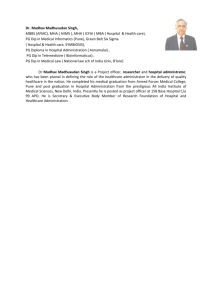
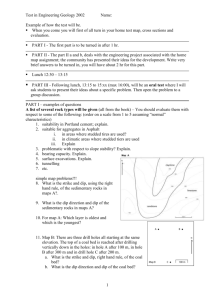
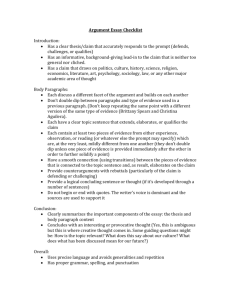
![[#FWDIP-74] PVSS invalid Bits (including range) are not all reflected](http://s3.studylib.net/store/data/007282728_1-8b675e5d894a5a262868061bfab38865-300x300.png)
